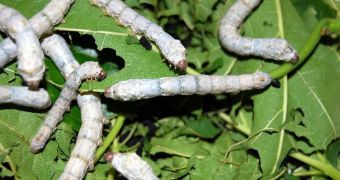Genetically-modified silkworms have been a goal for breeders for years. The most important goal that researchers tried for was to insert spider silk proteins into the silkworms, so that the latter would have been able to produce stronger silk. After years of failure, that objective was finally reached.
Successful combination of spider proteins with silkworms was achieved before, but the previous studies resulted in worms that yielded very little silk altogether. The benefits of having stronger silk were severely outweighed by the time it took to produce the necessary amounts of the material.
The research group that finally managed to crack this riddle was led by Dr. Donald Jarvis. The experts, based at the University of Wyoming, say that the new material could potentially have significant applications in real life, such as for example the creation of new bandages for burn victims.
Innovative new textiles and – conceivably – new types of bulletproof vests may also become a reality in the near future. Hopefully, this time around it will work, since many other studies tried to do the exact same thing, and failed.
Thus far, scientists used transgenic bacteria and modified natural cells to produce spider silk proteins, and they achieved relative success in doing so. Now that they can produce the molecules inside silkworms' silk, all they need to concentrate on is increasing production.
The new method is detailed in the latest issue of the esteemed journal Proceedings of the National Academy of Sciences (PNAS). In the paper, researchers list applications in both the medical and defense industries.
“Spider silks have enormous potential as biomaterials for various applications, but serious obstacles to spider farming preclude the natural manufacturing approach,” Jarvis said in an interview for The Telegraph.
“Thus, there is a need to develop an effective biotechnological approach for spider silk fiber production. In addition to being used as sutures, silk fiber hold great potential as biomaterials for wound dressings, artificial ligaments, tendons, tissue scaffolds, microcapsules, and other applications,” he added.
The main reason why researchers want to use spider silk instead of worm silk is that the former has superior mechanical properties. This means that it's stronger, more flexible, and also safer to use in biological applications, InHabitat reports.

 14 DAY TRIAL //
14 DAY TRIAL //